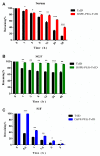DSPE-PEG Modification of α-Conotoxin TxID
- PMID: 31181805
- PMCID: PMC6627868
- DOI: 10.3390/md17060342
DSPE-PEG Modification of α-Conotoxin TxID
Abstract
In order to improve stability of a peptide marine drug lead, α-conotoxin TxID, we synthesized and modified TxID at the N-terminal with DSPE-PEG-NHS by a nucleophilic substitution reaction to prepare the DSPE-PEG-TxID for the first time. The reaction conditions, including solvent, ratio, pH, and reaction time, were optimized systematically and the optimal one was reacted in dimethyl formamide at pH 8.2 with triethylamine at room temperature for 120 h. The in vitro stabilities in serum, simulated gastric juice, and intestinal fluid were tested, and improved dramatically compared with TxID. The PEG-modified peptide was functionally tested on α3β4 nicotinic acetylcholine receptor (nAChR) heterologously expressed in Xenopus laevis oocytes. The DSPE-PEG-TxID showed an obvious inhibition effect on α3β4 nAChR. All in all, the PEG modification of TxID was improved in stability, resistance to enzymatic degradation, and may prolong the half-life in vivo, which may pave the way for the future application in smoking cessation and drug rehabilitation, as well as small cell lung cancer.
Keywords: PEG modification; stability; α-conotoxin TxID; α3β4 nAChR.
Conflict of interest statement
References
Figures





Similar articles
-
Effect of Methionine Oxidation and Substitution of α-Conotoxin TxID on α3β4 Nicotinic Acetylcholine Receptor.Mar Drugs. 2018 Jun 20;16(6):215. doi: 10.3390/md16060215. Mar Drugs. 2018. PMID: 29925760 Free PMC article.
-
Degradation kinetics of α-conotoxin TxID.FEBS Open Bio. 2019 Sep;9(9):1561-1572. doi: 10.1002/2211-5463.12697. Epub 2019 Aug 2. FEBS Open Bio. 2019. PMID: 31278882 Free PMC article.
-
Characterization of a novel α-conotoxin TxID from Conus textile that potently blocks rat α3β4 nicotinic acetylcholine receptors.J Med Chem. 2013 Dec 12;56(23):9655-63. doi: 10.1021/jm401254c. Epub 2013 Nov 22. J Med Chem. 2013. PMID: 24200193 Free PMC article.
-
α-Conotoxin [S9A]TxID Potently Discriminates between α3β4 and α6/α3β4 Nicotinic Acetylcholine Receptors.J Med Chem. 2017 Jul 13;60(13):5826-5833. doi: 10.1021/acs.jmedchem.7b00546. Epub 2017 Jun 21. J Med Chem. 2017. PMID: 28603989 Free PMC article.
-
DSPE-PEG: a distinctive component in drug delivery system.Curr Pharm Des. 2015;21(12):1598-605. doi: 10.2174/1381612821666150115144003. Curr Pharm Des. 2015. PMID: 25594410 Review.
Cited by
-
Effects of Various Marine Toxins on the Mouse Intestine Organoid Model.Toxins (Basel). 2022 Nov 24;14(12):829. doi: 10.3390/toxins14120829. Toxins (Basel). 2022. PMID: 36548726 Free PMC article.
-
Novel αO-conotoxin GeXIVA[1,2] Nonaddictive Analgesic with Pharmacokinetic Modelling-Based Mechanistic Assessment.Pharmaceutics. 2022 Aug 26;14(9):1789. doi: 10.3390/pharmaceutics14091789. Pharmaceutics. 2022. PMID: 36145535 Free PMC article.
-
Chemical Synthesis and Insecticidal Activity Research Based on α-Conotoxins.Molecules. 2024 Jun 14;29(12):2846. doi: 10.3390/molecules29122846. Molecules. 2024. PMID: 38930912 Free PMC article.
-
Integrating synthetic polypeptides with innovative material forming techniques for advanced biomedical applications.J Nanobiotechnology. 2025 Feb 12;23(1):101. doi: 10.1186/s12951-025-03166-8. J Nanobiotechnology. 2025. PMID: 39939886 Free PMC article. Review.
-
Doxorubicin-loaded PEGylated liposome modified with ANGPT2-specific peptide for integrative glioma-targeted imaging and therapy.Mater Today Bio. 2025 Jan 4;30:101455. doi: 10.1016/j.mtbio.2025.101455. eCollection 2025 Feb. Mater Today Bio. 2025. PMID: 39866777 Free PMC article.
References
-
- Dong-Ting Z., Yong W.U., Zhu X.P., Luo S.L. Sensitivity of α-Conotoxin TxID on Stoichiometry of α3β4 Nicotinic Acetylcholine Receptors. Chin. Pharm. J. 2016;51:802–808.
-
- Luo S., Christensen S., Zhangsun D., Wu Y., Hu Y., Zhu X., Chhabra S., Norton R.S., McIntosh J.M. A novel inhibitor of α9α10 nicotinic acetylcholine receptors from Conus vexillum delineates a new conotoxin superfamily. PLoS ONE. 2013;8:546–548. doi: 10.1371/journal.pone.0054648. - DOI - PMC - PubMed
MeSH terms
Substances
LinkOut - more resources
Full Text Sources

